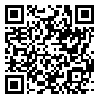دوره 8، شماره 3 - ( 5-1402 )
جلد 8 شماره 3 صفحات 391-383 |
برگشت به فهرست نسخه ها
Download citation:
BibTeX | RIS | EndNote | Medlars | ProCite | Reference Manager | RefWorks
Send citation to:



BibTeX | RIS | EndNote | Medlars | ProCite | Reference Manager | RefWorks
Send citation to:
Raeisi-Dehkordi H, Shekarkhand S, Faghih S. Dehydration among the Elderly: A Comparison between Nine Different Clinical and Metabolic Criteria. JNFS 2023; 8 (3) :383-391
URL: http://jnfs.ssu.ac.ir/article-1-554-fa.html
URL: http://jnfs.ssu.ac.ir/article-1-554-fa.html
Dehydration among the Elderly: A Comparison between Nine Different Clinical and Metabolic Criteria. Journal of Nutrition and Food Security. 1402; 8 (3) :383-391
چکیده: (2499 مشاهده)
Background: Dehydration, as a common problem in older adults, plays a significant role in morbidity and mortality. The elderly are more susceptible to dehydration and fluid deficiency due to age-related factors. There is not much literature concerning fluid intake in older adults. This study aims to investigate fluid intake and dehydration prevalence in older people and compare the accuracy of potential markers in the detection of dehydration. Methods: This cross-sectional study was done on 127 old people (48 males and 79 females) selected from a nursing home in Shiraz, Iran. Socioeconomic status was assessed via interview. Heart rate (HR), systolic blood pressure (SBP), diastolic blood pressure (DBP), urine specific gravity (USG), urine color (UC) and bioelectrical impedance analysis (BIA), extracellular water (ECW), intracellular water (ICW), and total body water (TBW) were measured. The fluid intakes were recorded using a beverage and fluid intake questionnaire. Total fluid intakes were compared using two fluid intake guidelines (European guidelines and US guidelines) as well. Furthermore, anthropometric indices were measured. Results: The mean age of participants was 73.01± 5.70 year. Fluid intake was 2.32 ± 0.48 liter/day. Based on urine specific gravity (USG) (˃1.020) and SBP (SBP ˂ 100 mmHg), 9.4% and 14.2% of the participants were dehydrated respectively. Among all hydration criteria, ECW had the highest potential for detection which identified 72.4% of participants as dehydrated. Among fluid intake guidelines, US guidelines were the best in dehydration diagnosis (112 individuals out of 127). Conclusions: Although urinary markers and physical indexes (SBP and HR) could not be used to determine hydration status, BIA measurements, especially ECW, have the potential to detect dehydration. In addition, daily fluid intakes are still practical for assessment of hydration status.
دریافت: 1400/10/17 | انتشار: 1402/6/6 | انتشار الکترونیک: 1402/6/6
| بازنشر اطلاعات | |
 |
این مقاله تحت شرایط Creative Commons Attribution-NonCommercial 4.0 International License قابل بازنشر است. |





